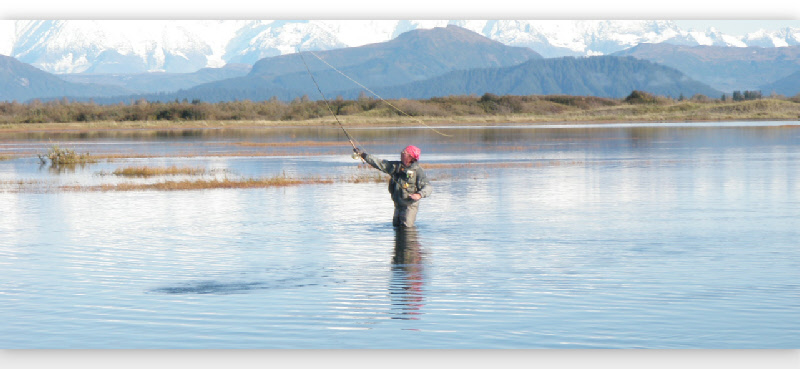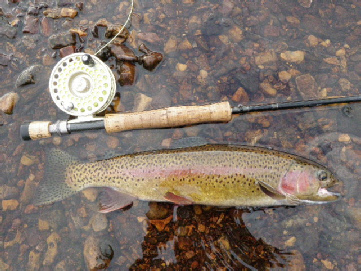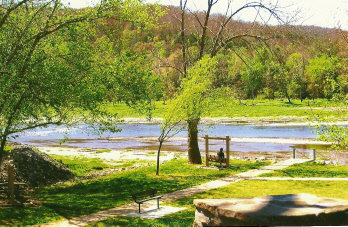



Shooting
Stream Report
Fly Fishing
Guide Services
Wing Shooting Instruct
Updates & More

Call 870-
To book your trip today!
White and Norfork Rivers
With over seven hundred river miles and three large impoundments (Beaver, Table Rock and Bull Shoals) the White River is by any standards, a very large river. Two other legendary rivers, the Norfork and the Little Red as well as their impoundments, Norfork Lake and Greer’s Ferry, respectively, join the White before reaching its final destination at the Mississippi River.

Built for flood protection and power generation in the 1940’s and continuing into
the 1960’s these five dams forever changed “the White River System” from a warm water
fishery to a cold water fishery. 
Before the dams were built there were no trout in the White River but there were lots of smallmouth bass. The release of cold water from the bottom of the dams proved too cold for the smallmouth bass and they were pushed downstream where the effects of the cold water are not so drastic. In an effort to mitigate the loss of the smallmouth bass fishery, trout were planted and they flourished in the cold, clear waters released from the dams.
The White River tail water below Bull Shoals is what is generally referred to as the middle part of the river and is where a great deal of the fishing and more importantly fly fishing is enjoyed.
The water warms as it winds and twists its way down stream eventually making it too warm for trout to survive. What makes the White so unique is the fact that the Norfork River dumps into the White about forty five miles down from the Bull Shoals dam. This influx of cold water released from Norfork Lake helps to keep the river cool enough to support trout for another forty of fifty miles.
Distance and the required driving times along curvy mountain roads makes it near impossible and definitely impractical to try to fish the entire stretch of cool trout waters. Arguably, the first fifty miles below Bull Shoals Dam provides perhaps the finest fly fishing to be found on the White and some have said “the nation”!
“Power demands are subject to change and the following should not be relied upon to predict safe water conditions”.
This is where the whole thing starts to get a little dicey. Primarily built for
flood protection by The Army Corps of Engineers,  the dams also serve to provide hydroelectric
power needed to satisfy the nations growing population. Hence, another player comes
into the equation. Southwestern Power Administration, through agreements with the
government has authority to request water release’s needed for power demands.
the dams also serve to provide hydroelectric
power needed to satisfy the nations growing population. Hence, another player comes
into the equation. Southwestern Power Administration, through agreements with the
government has authority to request water release’s needed for power demands.
When and how much water is going to be released is anybody’s guess. In reality SPA does try very hard to provide accurate predictions as to when and how much, but as anyone who has fished the White can attest, “who knows”. One really needs to have a pretty good sense of humor or a pretty large vocabulary because there can be some trying moments fishing, or trying, to fish the White River.
Better than cussin, or even humor, a well laid plan is going to keep you fishing and catching fish when the other guys are trying to figure out what to do next. This is where the services of an experienced guide can make the difference between having the time of your life or packing it up and heading home.
With several launch sites and two rivers to choose from, your guide can help take the guess work out of the equation. The water may be dead low below the dam but still be four feet high down the river a few miles. Your guide will know just what to do and where to do it. Choosing launch sites, exploring wading opportunities and determining where to go, fly selection and presentation are all part of the services Ken will provide.
From White Hole to Shipps Ferry all the ways down to Red’s Landing, determining where to fish is often not determined until the generation schedules has been posted and deciphered. Of course other variables such as season, water clarity, forecasted conditions and what seasonal food sources may or not be available play a big part as well. Ken Minsky’s Loch Leven will do what is needed to remove the guess work and keep you on the river and on the fish!
Bull Shoals Lake
Completed in the summer of 1951 Bull Shoals is one of the largest (5th) concrete dams in the nation. It is huge and its been said that some of the cement used in its creation has yet to set to concrete. Whether that is true or not is anybody’s guess. And when it comes to guessing, walk on down to the waters edge, take a good long look and you’ll most likely be asking yourself, ok, now what?
Good question, the same exact one everyone else who has ever got the notion to try their luck fishing Bull Shoals has asked. And I’ll let you in on a little secret; lots of folks who have been coming here for years are still asking the same darn thing.
With over 700 miles of shoreline and 45,000 surface acres at conservation pool (654 feet above sea level) Bull Shoals Lake is not only big, its intimidating. Raise the lake level to the top of its flood pool of 695’ the lakes size increases to over 1000 miles of shoreline and more than 70,000 acres. That’s not considered big anymore that’s a Behemoth!
The good news is it’s loaded with fish, all kinds of fish! Largemouth, smallmouth and spotted bass are abundant, as are white bass, crappies, bream (bluegill) and other sunfishes. Somehow yellow perch got into the mix a while back and some of those are in the high ‘teens for length and make for mighty good table fare. Throw in a full complement of trout, catfish and the odd (but huge) striper and you’ve got yourself a lake full of fish. For a little icing on the cake, the ever popular walleye tops off the list in most everybody’s book. With no closed seasons and moderate temperatures Bull Shoals offers fishing year round with the fall and winter months offering some of the best fishing to be found.
Labyrinthine in nature, saying Bull Shoals is a little tuff to figure out is a gross understatement. As George W. would say, don’t “misunderestimate”it.! Its big, its deep, its clear and it can be tuff as hell at times. Arm yourself with the inherent limitations of the fly rod and you got yourself a challenge.
But as we all know “the greater the challenge, the greater the rewards". And the rewards can indeed be great at times, but it’s not easy. Fly fishing Bull Shoals is something you just don’t see people doing. Not because it “can’t be done” most people just don’t realize “it can be done” and they darn sure don’t know how to go about it.
Fact is you can enjoy reasonable success with just your standard mid weight to heavy weight trout fishing gear. However to achieve better results its best to bring along at least a six weight and an eight or nine weight would be even better. Because Bull Shoals is deep and clear, sink tip and full sinking lines will go a long way in helping get your fly down to where it needs to be. Seasons and species will generally dictate water depth and presentation. However even in the spring you may find yourself fishing in 3 feet of water (total depth) during the morning and 20 feet down over 100 feet of water during the evening. Knowing where, when and what to use is always the big question.
Ken Minsky’s Loch Leven can help straighten the maze. Having lived on and fished Bull Shoals Lake for nearly fifteen years Ken has located some of the most productive spots to be found . He has also refined techniques that will help coax reluctant, neutral and negative fish to strike. One of the most frequently asked questions people have for Ken is; can you really catch walleyes with a fly rod? And in a word; Yes, you bet you can catch walleyes with a fly rod! And although not usually targeted, Ken has also been known to boat the occasional catfish with the fly rod as well.
Largemouth, smallmouth and spotted bass along with white bass and walleye are the usual targets but don’t be surprised when you hook into a hard fighting rough fish like the drum or one of the many species of gar inhabiting the lake. Although not known for their tastiness drum and gar are hard fighters and when they get sideways on you can put up one heck of a fight!
Bluff walls, gravel points and major creek arms including Shoal, Trimble, Buck and Sugarloaf are all nearby and are some of the best spots on the lake. Sunken fish cribs and attractors are also scattered throughout the lake and can dish up some bragging size fish and lucky for you, Ken knows 'em all!
Ken Minsky’s Loch Leven is centrally and conveniently located on the south side of the lake on Five Finger Bay, just a few miles west of the Hwy 125 Ferry crossing. With paved roads all the way it’s an easy drive whether you’re staying in Branson or the Bull Shoals area.
Call Ken soon to book a trip on the lake or better yet a combination trip fishing both the river and the lake!
